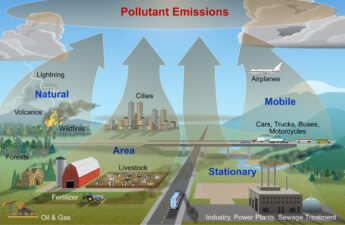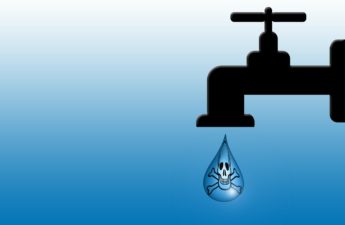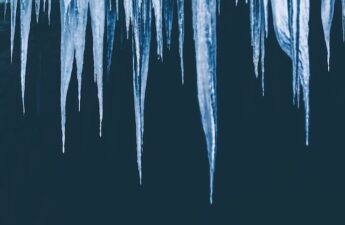Wildfire Smoke Preparedness during the COVID-19 Pandemic
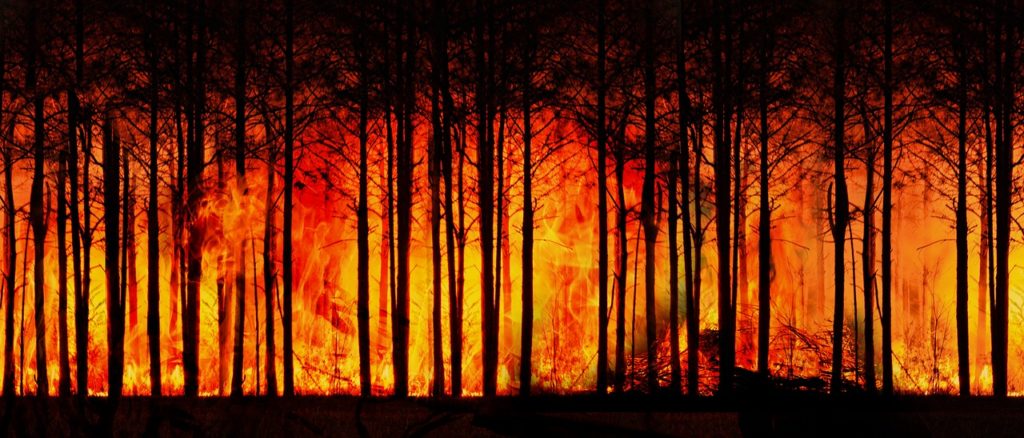
By PHSKC-Environmental Health Services Division and Puget Sound Clean Air Agency (PSCAA)
Summer is almost here. For us in the Puget Sound, that also means the threat of wildfire smoke.
This year is different as we continue to respond to spread of the novel coronavirus (COVID-19). Smoke may create additional risk for people with COVID-19 and worsen symptoms.
So while wildfire smoke may seem like a less pressing threat in light of the global pandemic, COVID-19 gives us even more reason to be prepared for wildfire smoke this summer.
What is the health threat from wildfire smoke?
Wildfire smoke is unhealthy for everyone, but children, pregnant women, stroke survivors, and people who are over 65 years of age or who have a respiratory disease or illness, heart disease or diabetes are especially vulnerable to smoke. It contains small particles and other chemicals that can irritate your eyes, nose, throat and lungs.
It can cause your eyes to burn and your nose to run. Smoke can cause wheezing, coughing, shortness of breath and headaches.
It can also worsen any existing lung, heart, or circulatory condition people may have, like triggering asthma attacks. For most people symptoms are relatively minor, but impacts for those most vulnerable can be serious or even deadly.
Wildfire Smoke Increases Health Risks for People with COVID-19
Wildfire smoke may increase the severity of symptoms for people with COVID-19. COVID-19 can make it much harder to breathe.
Poor air quality caused by wildfire smoke may make it even harder for people to fight COVID-19 since both have the potential to affect the lungs, and other overlapping parts of the immune system.
Many people most susceptible to COVID-19 are also those most vulnerable to the impacts of wildfire smoke.
How to Be Prepared for Wildfire Smoke this Year
Prepare your home –
Filtering the air in your home will reduce risk to COVID-19 as well as smoke. Filtered air will reduce smoke levels and the amount of virus circulating in the air indoors.
However, filtering air indoors alone will not be enough to protect you from the spread of COVID-19, and best practices of social distancing, hand washing, and others measures should still be followed.
- If you have an HVAC system, buy filters that have the highest designated filter rating that the manufacturer recommends. Use the “recirculation” mode during wildfire smoke events. This is the best way to improve indoor air quality though out your home rather than just a single room.
- Purchase an indoor portable air cleaner that has a “clean air delivery rating” for the size of the room where you intend to use it. Select a portable air cleaner that does not create ozone by selecting a portable air cleaner that has been certified by the California Air Resources Board, an approved list of portable air cleaners can be found on their website. More information on indoor air filters is available on the EPA’s website.
- Creating your own air filter is a low-cost way to improve the air quality of a single room in your home, allowing you to create a cleaner air space. Information on how to make a Do-It-Yourself (DIY) portable air cleaner and important safety tips to follow can be found on Puget Sound Clean Air Agency’s website.
When it gets smoky, you will also need to take steps to reduce indoor sources of air pollution by keeping windows and doors closed and by avoiding activities like burning candles, smoking indoors, or vacuuming, unless you use a vacuum with a HEPA filter.
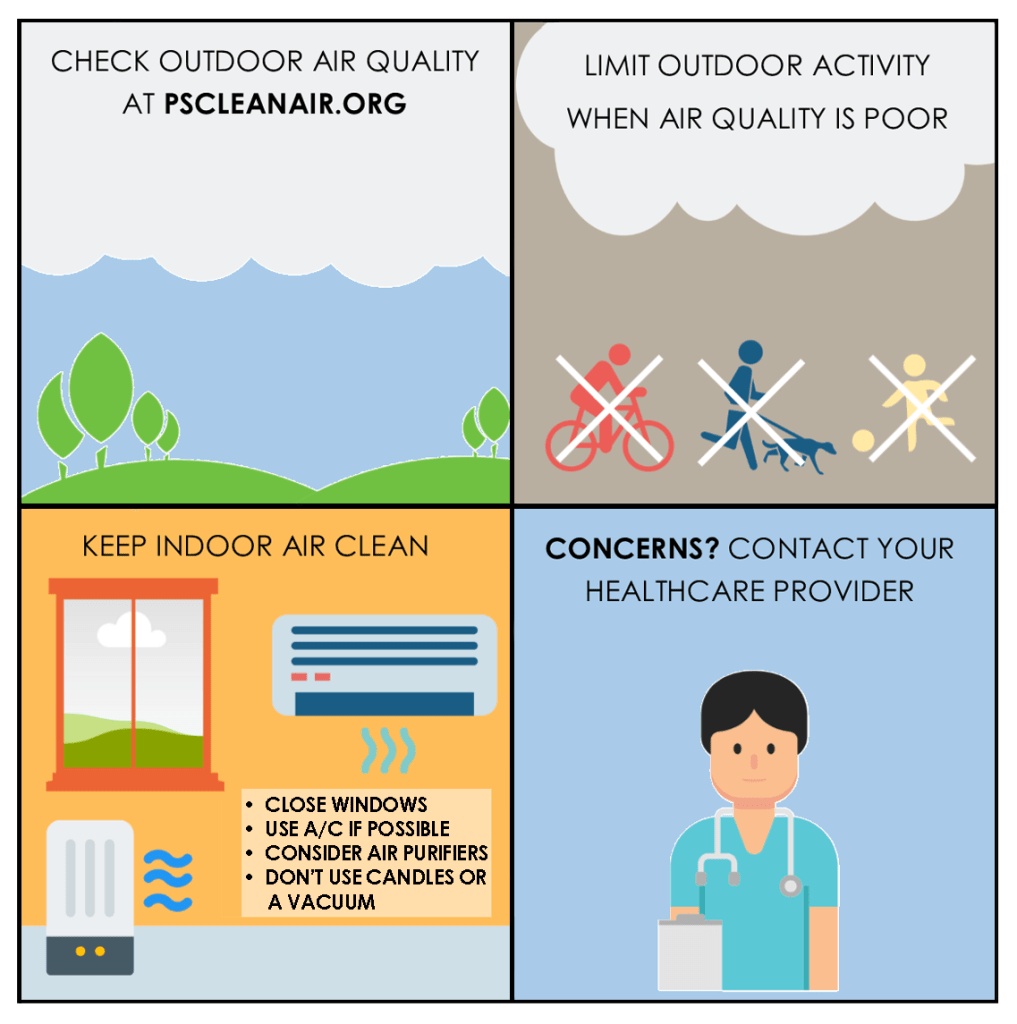
Know where you can go –
If the air quality is poor, stay indoors to the extent possible. Public locations with cleaner and cooler air may not be open, or have lower capacity this year. During COVID-19, we need to stay safe by keeping six feet apart. This will make it difficult to open public spaces as clean air centers if we experience wildfire smoke.
Call ahead to see if locations are open to the public and what physical distancing measures may still be in place.
Creating a clean air space inside your home is likely your best option to get relief from wildfire smoke this season.
If you have an existing medical condition, talk with your healthcare provider –
Anyone with an existing medical condition such as heart disease, diabetes, asthma or chronic obstructive-pulmonary disease (COPD) should talk with their healthcare provider about how to decrease your risk from wildfire smoke.
Create a personal wildfire smoke plan and make sure you have any necessary medications or prescriptions on hand before wildfire smoke season starts. Consider stocking up on food and other necessary supplies too.
If you have older family members or friends, help them plan for wildfire smoke this season.
Learn how to stay informed about air quality conditions and wildfire smoke forecasts –
There are many resources available to stay informed about the status of air quality in your area.
Air quality conditions may change quickly. Check the air quality forecast regularly at the Puget Sound Clean Air Agency’s website.
You can find Puget Sound Clean Air Agency online at: www.pscleanair.gov/
Washington Wildfire Smoke Blog: https://wasmoke.blogspot.com/
Additional resources include:
- Smoke From Fire tips – Washington Department of Health
- Smoke Ready Toolbox – U.S. Environmental Protection Agency
What about masks?
Public Health officials have directed people in King County to wear face coverings over their noses and mouths when outdoors and indoors in public locations when they can’t stay six feet apart.
Cloth and surgical masks generally provide very little protection against wildfire smoke. N95 respirators, when well fitted and worn properly can provide protection against wildfire smoke.
Due to COVID-19, N95 and other NIOSH approved respirators are in short supply. We should save these respirators for healthcare and frontline workers fighting COVID-19.
Guidance on how to wear a face coverings for COVID-19 can can be found on our blog here
